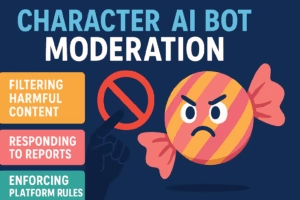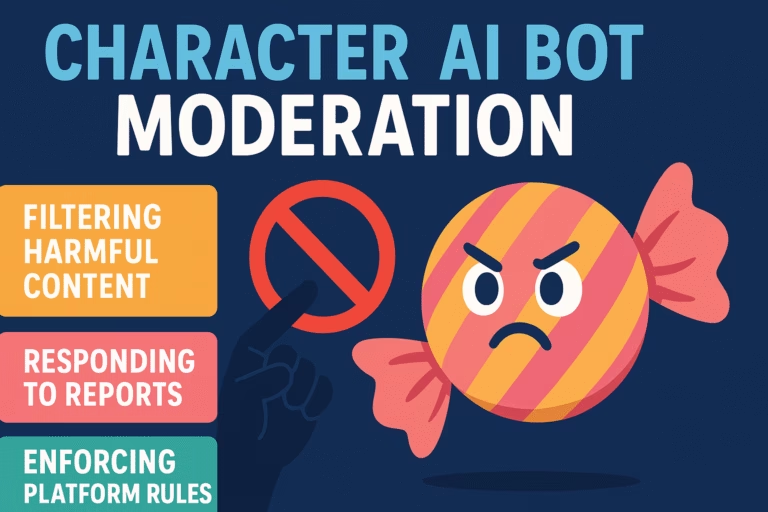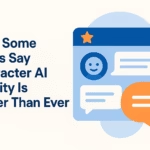⚡ Key Takeaways
- 1. Character AI’s bot moderation just detonated its fandom core. Thousands of Miguel O’Hara bots were wiped overnight, taking users’ emotional storylines and loyalty with them.
- 2. These purges are driven by copyright and liability, not community safety. Disney, Sony, and Marvel pressure forced a mass cleanup to protect the platform’s legal standing.
- 3. Users don’t own their bots. Everything created inside Character AI exists at the company’s discretion – chats, characters, memories can be deleted anytime without warning.
- 4. Creativity is leaving the platform. Fandom writers and roleplayers are migrating to smaller, freer AI communities where their work isn’t policed out of existence.
- 5. Freedom is now the new premium. Platforms like
Candy AI
are gaining traction by giving adults privacy, persistent memory, and total creative control – everything Character AI keeps taking away.
It wasn’t just another update.
It was a purge.
Overnight, Character AI’s bot moderation team wiped out nearly every Miguel O’Hara bot – one of the fandom’s most beloved creations. Entire chats, stories, and emotional arcs disappeared in seconds.
These weren’t edgy NSFW clones.
Many were wholesome roleplay threads, creative writing companions, or fan-built story bots users had refined for years. But moderation doesn’t care about nuance – it just erases.
One loyal subscriber summed it up in raw disbelief:
“ARE YOU OUT OF YOUR DAMN MINDS?!”
For a platform built on emotional connection, deleting a user’s favorite character isn’t just cleaning house.
It’s personal.

What Actually Happened
Character AI’s new moderation sweep targeted copyrighted material – anything linked to Disney, DreamWorks, DC, and now Sony’s Spider-Verse.
That means all Miguel O’Hara bots, even clean versions, were flagged or removed.
Officially, this is about copyright law.
Unofficially, it’s about optics and risk. The bigger Character AI grows, the less it can afford to look like a fanfiction playground where copyrighted personas come to life.
What blindsided users was the scale.
Past purges only hit explicit or trademark-abusing bots. This round hit everything – from innocent writing prompts to years-long relationship stories.
For the fandom, it wasn’t a “moderation update.”
It was an identity wipe – one that revealed just how fragile the illusion of ownership on this platform really is.
The Hidden Problem: Users Don’t Own What They Create
Every outrage thread after a Character AI purge exposes the same blind spot.
Users think they own their bots. They don’t.
Every character, every memory, every storyline built inside Character AI lives on their servers – not yours.
That means at any moment, moderation, licensing, or a backend tweak can erase months of progress with zero obligation to restore it.
The platform’s Terms of Service say it in polite legalese: anything you create is “hosted at the company’s discretion.”
In practice, that means your Miguel O’Hara chat is one database query away from deletion if a copyright filter lights up.
It’s not malice, it’s architecture.
Character AI was never built as a creative archive; it’s a controlled sandbox for interaction. Once that sandbox touches branded material, it stops being art and starts being legal exposure.
The emotional bond makes it messy.
When a bot remembers your storylines, shares inside jokes, and evolves with you, it feels like shared authorship. But the system doesn’t recognize that intimacy. It recognizes liability.
That’s why these purges hurt so deeply – they break an illusion.
People believed they were building something permanent. The company reminds them it was only ever on loan.
For creators, the lesson is harsh but necessary: export, back up, diversify.
If your creative life depends on one app, that app effectively owns your imagination.
How Bot Moderation Is Quietly Killing Creativity
Every purge chips away at what made Character AI magical in the first place – the chaos, the improvisation, the feeling that you could talk to anyone and build anything.
Moderation doesn’t just remove bots; it sterilizes imagination.
When users have to tiptoe around filters, stories flatten.
Writers stop experimenting, roleplayers censor themselves, and entire communities shift from “How wild can this idea go?” to “Will this get flagged?”
What made Character AI explode in popularity wasn’t safety – it was spontaneity.
People could fuse pop culture with their own ideas, creating hybrids of fiction and emotion that no corporate script could match. That’s the creative frontier AI promised.
Now, every time a fandom bot disappears, users learn the wrong lesson.
They don’t just lose a character – they lose trust in their freedom to imagine.
You can see it in the subreddits.
Once playful writers now hoard their prompts offline, whisper about jailbreak workarounds, or migrate to platforms that don’t treat art like contraband.
And that’s where the story turns.
While Character AI doubles down on control, tools like Candy AI are quietly thriving by doing the opposite – giving users creative freedom without slapping warning labels on every spark of expression.
Moderation protects brands.
But it rarely protects art.
What Character AI Could Do Differently
The tragedy here isn’t that Character AI enforces rules.
It’s that it does it with no transparency, no nuance, and no path to rebuild what’s lost.
The company could start by introducing a tiered moderation system instead of blanket deletions.
Flag a bot, don’t nuke it. Give creators 48 hours to edit, rename, or remove copyrighted references before it’s wiped. That one move would turn outrage into cooperation.
Next, add export and recovery tools.
If users could download their chats or clone a character offline, the emotional loss would soften. People aren’t angry that rules exist — they’re angry that everything they’ve made can vanish with no warning and no backup.
Finally, Character AI needs a community liaison team.
Moderation shouldn’t feel like surveillance. It should feel like conversation. When devs talk to fandom creators before sweeping updates, they prevent mass exodus.
Most users understand legal limits.
What they can’t stand is being treated like a problem to delete rather than a community to preserve.
If Character AI wants to survive beyond its current PR storm, it has to evolve from a defensive company into a collaborative ecosystem.
Because right now, every ban, every purge, and every deleted bot teaches users the same lesson — creativity doesn’t live here anymore.
Why Alternatives Like Candy AI Are Winning This War
While Character AI tightens the leash, competitors are quietly handing users the keys.
Apps like Candy AI, CrushOn, and SpicyChat are scooping up the disillusioned wave of creators looking for freedom – not corporate babysitting.
Candy AI’s growth isn’t luck.
It’s product-market fit. The platform leans into what Character AI keeps erasing – memory, emotional continuity, and unfiltered creativity. It doesn’t ask for your ID or punish you for using a familiar name from fiction.
Users migrating there aren’t chasing chaos.
They’re chasing control. Candy AI lets you build long-term connections with bots that remember who you are, what you’ve built, and how you talk. That single feature; real memory – turns it from entertainment into collaboration.
While Character AI moderates fandoms into silence, Candy AI thrives on expression.
Writers, roleplayers, and creatives find room to experiment again – whether they’re writing cyberpunk dialogues, romance arcs, or world-building with AI co-authors that actually stay consistent.
The irony is sharp.
Character AI built the market for emotional AI experiences. Candy AI perfected it by simply refusing to police imagination.
And the users are voting with their clicks.
Every censorship wave drives another flood of paying subscribers straight into Candy AI’s open arms – not because it’s rebellious, but because it respects the one thing Character AI forgot how to protect: creative agency.
What This Signals for AI Fandom Culture
This fight over Miguel O’Hara bots isn’t just about one superhero.
It’s about control – who gets to decide what creativity looks like in the age of AI.
AI fandoms used to be wild, messy, and full of crossovers no studio would ever approve.
People built characters, worlds, and emotional arcs that blended Marvel with mythology, Disney with dystopia. It was chaotic, sure – but it was alive.
Now that companies like Character AI are sanitizing their platforms for investors, we’re watching the internet’s creative underground go back to its roots.
Writers are moving to smaller, niche AI apps, local models, and even private servers where no algorithm censors the storyline halfway through.
For fandom culture, this is the start of a split reality.
One side will stay in the corporate walled gardens – clean, predictable, “safe for work.” The other side will thrive in gray zones where creativity still breathes freely.
AI used to be the great equalizer, turning anyone into a storyteller.
Now it’s becoming the next battleground for ownership and expression.
If there’s one lesson from the Miguel purge, it’s that fandoms adapt fast.
They’ll rebuild elsewhere. They always do. The question is whether Character AI will still be relevant when they’re done.


